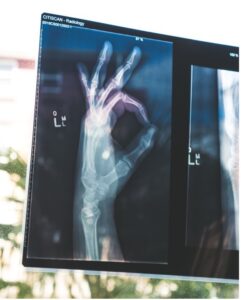Hand and wrist fractures encompass a spectrum of injuries involving cracks or breaks in the bones of your wrist, hand, or fingers. These injuries can arise from various causes, with the most frequent occurrence being a distal radius fracture – typically the result of attempting to cushion a fall with an outstretched hand. I’m sure just the thought of that is making you cringe because we’ve all been there.
Other common fractures include those of the scaphoid bone, metacarpals, and phalanges (small finger bones). Let’s dive into more detail to better understand hand and wrist fractures and their symptoms.
Signs and Symptoms of Hand and/or Wrist Fractures
Partaking in activities like in-line skating or snowboarding can heighten your risk of these fractures, as can conditions like osteoporosis, where bones become brittle. Recognizing and addressing hand and wrist fractures promptly is vital. Failing to do so could result in misaligned healing, impacting everyday tasks like writing or buttoning a shirt. Swift intervention also minimizes pain and stiffness.
Indications of a Hand or Wrist Fracture Can Include:
• Intense pain that may worsen with hand or wrist movement, gripping, or squeezing.
• Swelling.
• Tenderness.
• Bruising.
• Obvious deformities, such as a bent wrist.
A Hand/Wrist Fracture Diagnosis
To diagnose a hand or wrist fracture, a physical examination of the affected area is usually accompanied by X-rays. Additional imaging methods can provide more detailed insights, such as:
• CT scan: This technology combines X-rays from different angles to create cross-sectional images, uncovering fractures that may be missed by standard X-rays and identifying soft tissue and blood vessel injuries.
• MRI: This technique uses powerful magnets and radio waves to generate detailed images of bones and soft tissues. MRIs are highly sensitive and can detect even minor fractures and ligament injuries.
Treatment of a Hand/Wrist Fracture
Proper alignment of fractured bone ends is crucial. Your doctor may perform a reduction, repositioning bone fragments, either with local or general anesthesia. Moving uninjured fingers regularly during healing is important to prevent stiffness. Immobilization via splints or casts restricts movement for optimal healing. Keeping the hand elevated above the elbow reduces swelling and pain.
Medications for a Hand/Wrist Fracture
Pain relief can be attained with over-the-counter pain relievers. Narcotic medications are rarely necessary, and NSAIDs might help with pain but could hamper bone healing if used long-term. If there’s an open fracture (where skin near the wound site is broken), antibiotics may be prescribed to prevent bone infection.
Hand Therapy after a Hand/Wrist Fracture
Following cast or splint removal, hand therapy aids in restoring movement and minimizing stiffness. While rehabilitation can be lengthy, it is instrumental in achieving complete healing.
Surgical Options if You Have a Hand/Wrist Fracture
Monitoring progress via X-rays is critical, as bones can shift even after reduction and immobilization. Surgery might be required in cases of bone movement, and options include:
• Closed reduction and pinning: Temporary pins hold aligned fractures until healing, after which they’re removed.
• External fixation: A metal frame outside the body immobilizes fractures with pins passing through the skin and bone. The frame is removed once healing occurs.
• Open reduction and internal fixation: This involves implanting pins, plates, rods, or screws to hold bones in place. Bone grafts might also be employed.
These surgical measures may be necessary for various reasons, including joint involvement, open fractures, or loose bone fragments affecting ligaments, nerves, or blood vessels. If you’re in need of expert care for hand and wrist fractures, contact a MI hand doctor for specialized guidance and treatment. There are many reputable hand doctor options from the Ascension or Beaumont healthcare systems, or you can choose Top Doc Dr. Avery Arora of Arora Hand Surgery. You can schedule an appointment at one of Dr. Arora’s four offices in West Bloomfield, Warren, Macomb, or Howell, Michigan today.














